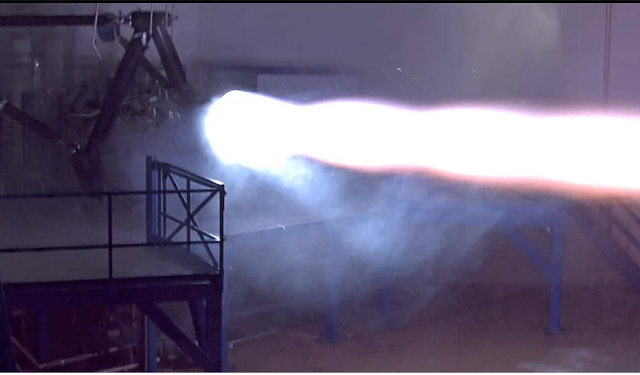Elon Musk tweeted that the first test firing of the new Spacex Raptor engines have been performed.
Chamber pressure is almost 3X Merlin, so engine is about the same size for a given area ratio
Production Raptor goal is specific impulse of 382 seconds and thrust of 3 MN (~310 metric tons) at 300 bar
Elon Musk will addresss the 67th annual International Astronautical Congress tomorrow and he will outline his plan for interplanetary colonization beginning with Mars.
SpaceX propulsion just achieved first firing of the Raptor interplanetary transport engine pic.twitter.com/vRleyJvBkx— Elon Musk (@elonmusk) September 26, 2016
Mach diamonds pic.twitter.com/TCX7ZGFnN0— Elon Musk (@elonmusk) September 26, 2016
Tomorrow: Elon Musk will speak at @IAC2016 on making life multiplanetary. Tune in at 1:30 CT on https://t.co/SwNQJ9Ht4D pic.twitter.com/m05qggxkng— SpaceX (@SpaceX) September 26, 2016
Raptor will utilize a full-flow staged combustion cycle, where 100 percent of the oxidizer—with a low-fuel ratio—will power the oxygen turbine pump, and 100 percent of the fuel—with a low-oxygen ratio—will power the methane turbine pump. Both streams—oxidizer and fuel—will be completely in the gas phase before they enter the combustion chamber. Prior to 2014, only two full-flow staged combustion rocket engines have ever progressed sufficiently to be tested on test stands: the Soviet RD-270 project in the 1960s and the Aerojet Rocketdyne integrated powerhead demonstration project in the mid-2000s
The Raptor engine is designed to work using deep cryogenic methalox propellants—fluids cooled to near their freezing points rather than nearer their boiling points which is more typical for cryogenic rocket engines.
The turbopump and many of the critical parts of the injectors will be manufactured by using 3D printing, which also increases the speed of development and iterative testing.
Additional characteristics of the full-flow design that are projected to further increase performance or reliability include:
- eliminating the fuel-oxidizer turbine interseal, which is a potential point of failure in more traditional engine designs
- lower pressures are required through the pumping system, increasing life span and further reducing risk of catastrophic failure
- ability to increase the combustion chamber pressure, thereby either increasing overall performance, or “by using cooler gases, providing the same performance as a standard staged combustion engine but with much less stress on materials, thus significantly reducing material fatigue or [engine] weight
Stated design size for the Raptor engine has varied widely as design continues, from a high target of 8,200 kN (1,800,000 lbf) of vacuum thrust to a more recent, much lower target of 2,300 kN (510,000 lbf). Estimates target a vacuum Isp of 363 seconds and a sea-level Isp of 321 seconds. Final thrust and Isp specifications for the as-built engines may continue to change dramatically as SpaceX moves the engine through the multi-year development cycle
SpaceX announced an ambitious plan to send its first uncrewed Dragon capsule to Mars as early as 2018. The Merlin engine — which uses kerosene and liquid oxygen as propellants — will power the Falcon 9 and future Falcon Heavy launch vehicles, the Raptor engine will power the next-gen rocket.
SOURCES -twitter, Wikipedia

Brian Wang is a Futurist Thought Leader and a popular Science blogger with 1 million readers per month. His blog Nextbigfuture.com is ranked #1 Science News Blog. It covers many disruptive technology and trends including Space, Robotics, Artificial Intelligence, Medicine, Anti-aging Biotechnology, and Nanotechnology.
Known for identifying cutting edge technologies, he is currently a Co-Founder of a startup and fundraiser for high potential early-stage companies. He is the Head of Research for Allocations for deep technology investments and an Angel Investor at Space Angels.
A frequent speaker at corporations, he has been a TEDx speaker, a Singularity University speaker and guest at numerous interviews for radio and podcasts. He is open to public speaking and advising engagements.




